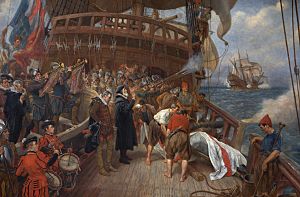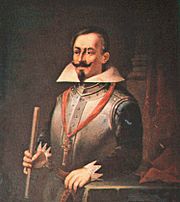Drake's Assault on Panama facts for kids
Quick facts for kids Drake's Assault on Panama |
|||||||
|---|---|---|---|---|---|---|---|
| Part of the Anglo–Spanish War | |||||||
 Burial of Drake off Panama in 1596, painting by Thomas Davidson |
|||||||
|
|||||||
| Belligerents | |||||||
| Commanders and leaders | |||||||
| Alonso de Sotomayor Juan Enríquez Conabut |
Francis Drake † Thomas Baskerville |
||||||
| Strength | |||||||
| Various shores defences 200 soldiers & militia |
15 ships 600 soldiers & sailors |
||||||
| Casualties and losses | |||||||
| Unknown | Heavy Many to disease 2 ships scuttled |
||||||
Drake's Assault on Panama, also known as the Defence of Panama, was a big military event in January 1596. It happened during the Anglo–Spanish War between England and Spain. An English team led by Francis Drake and Thomas Baskerville tried to attack the Spanish Main (parts of the Spanish Empire in the Americas).
Their plan was to land at Nombre de Dios and then cross the isthmus of Panama. But the English soldiers got very sick with a disease called dysentery and other illnesses. The Spanish forces stopped them, and the English were defeated. Francis Drake himself died from dysentery, and the English team had to go back to England. The Spanish kept bothering them all the way home.
Contents
Why the Attack Happened
In 1595, Queen Elizabeth I of England sent Francis Drake and John Hawkins on a trip. Their goal was to attack the Spanish Main. They wanted to hit Spain where it hurt most: its supply of gold and silver from its West Indian Fleet.
The English first tried to capture San Juan in Puerto Rico. They used 27 canoes and had 2,500 men. But this attack failed because the Spanish had made their defenses much stronger. Drake decided not to attack San Juan again. Instead, he sailed south to find easier targets.
However, many English soldiers started getting sick. John Hawkins died shortly after, near Puerto Rico. Thomas Baskerville then became the second-in-command.
The English team then sailed towards South America. They captured the town of Rio de la Hacha and nearby places like La Ranchería. They got a lot of treasure there. When a ransom deal failed, Drake burned the area.
Next, they attacked Santa Marta. The Spanish had been warned, so the city was empty. But the English captured the Spanish Governor, Francisco Ordonez Flores. They got 4,000 ducats (a type of money) for his release, and then they burned the town.
By this time, many English sailors and soldiers were sick. Attacking Cartagena de Indias seemed too risky. So, Drake decided to try something different. He wanted to march across the narrow strip of land called the isthmus of Panama. He hoped to claim it for England. He headed for Nombre de Dios. From there, he planned to send his troops, led by Baskerville, to the Pacific Ocean. Their goal was to capture the port of Panama, which was an important Spanish base for sending gold and silver to Spain.
The Spanish in Central America were ready for them. Alonso de Sotomayor had been sent by the Viceroy of Peru to set up defenses. These defenses were along the Camino Real (a royal road) and the Chagres River. These spots would block any English attempt to move west.
Attacking the Isthmus
Nombre de Dios Landing
On January 6, 1596, Drake and his men arrived at Nombre de Dios. They landed without anyone stopping them. To take the town, they first had to capture a small fort. About a hundred local soldiers were defending it. Baskerville ordered an attack, and the English quickly took the fort. The town was captured easily, but there wasn't much treasure. The Spanish had been warned and had left the town, hiding in the jungle.
Drake stayed for two weeks and tried to get a ransom for the town. When no one paid, he ordered the town to be destroyed by fire. All the ships in the harbor were robbed and then burned. They didn't find much money in the town itself. But they found a watchtower on a nearby hill. Inside it was a chest of silver, two gold bars, some pearls, and other valuable items.
Battle at Capirilla Hill
Baskerville chose 750 men to clear the area of any hidden Spanish groups. On January 20, they began a dangerous march along the old Panama road. Two days later, they took a small settlement called Venta de la Quebrada.
On the third day, after a very tiring march in constant rain and high humidity, Baskerville faced a challenge. He found a deep valley near another settlement called Capirilla. The path ahead became very steep, and a dangerous hill overlooked the road. At the top of the hill was a strong defensive position. It had a narrow pass and a barrier of cut trees that was impossible to get through. About seventy Spanish soldiers, led by Captain Juan Enríquez Conabut, were dug in there. They were ready to stop the English from crossing the isthmus.
Baskerville ordered an attack to take the hill. But the Spanish had chosen their spot well. The English tried for three hours to push the defenders out. Each time they attacked, they were pushed back and lost many soldiers. Then, fifty more Spanish soldiers joined the fight. They were led by Captain Hernando de Lierno Agüero, and their arrival changed the battle.
By this time, half of Baskerville's supplies and ammunition were ruined by the rain and humidity. Even if he took the hill, he realized he would have to fight through many more such obstacles to reach Panama. He wouldn't have enough soldiers left to hold it. The English retreated, leaving the hill to the winning Spanish. The English lost over sixty men, including Baskerville's brother Nicholas. The Spanish lost only seven men, with some wounded.
Baskerville's group, many of them sick and now sad, sent a message to Drake. They asked him to meet them with supplies and 200 men on their way back. The tired group finally met Drake at Nombre de Dios on January 22. Drake and his crews felt very low. Three days later, they sailed west.
Drake's Final Days
On January 27, Drake's ships stopped near Escudo de Veraguas Island. But his forces were now very sick. Thirty-seven of the strongest men tried to get water from the Fator River. They were attacked by angry Spanish residents (many of them freed slaves) from the nearby mainland town of Santiago del Príncipe. Most of the English group were killed, with only a few escaping.
After this sad news, Drake ordered the ships to sail east towards Porto Bello. But within a few days, he himself became very sick with dysentery.
On the night of January 28-29, 1596, Drake died on his main ship, the Defiance. The next morning, before he died, Drake asked to be dressed in his full armor. He was buried at sea in a lead-lined coffin. This happened off Buenaventura Island, near Porto Bello.
Baskerville took command of the ships. He thought about attacking Santa Marta again, but decided against it. Instead, he ordered his sad men to sail towards Santiago.
They had heard that a fleet of sixty Spanish ships had been sent to stop them. They thought these ships would be waiting at the Yucatan Channel to block their way home. So, they decided to stay together and try to escape by the same route they came. To do this, they combined their ships and reorganized. Thomas Drake (Francis Drake's relative) was made vice-admiral. With the crews even weaker from disease, Baskerville finally led a retreat back to England. During the journey, two ships, the 195-ton Elizabeth and the 50-ton Delight, were sunk because they were in bad condition and didn't have enough crew to sail them.
What Happened Next
The Spanish ships caught up with the English near the Isla de la Juventud. In the battle that followed, called the Battle of Pinos, the English managed to fight off the Spanish fleet and escape back to England.
Even though the English trip failed, Spain didn't get enough gold. In 1597, Philip II of Spain couldn't pay his debts. He couldn't get money for the last two years of his rule.
News of Drake's death made people happy along the Spanish Main. In Spain, religious people saw it as a sign that God had finally stopped him from bothering them. The Spanish poet Lope de Vega wrote a happy poem to celebrate that the "scourge of the Church" was gone.
When England heard about the defeat, Queen Elizabeth demanded revenge for this "humiliation." To show that England's navy was still strong, she ordered George Clifford, 3rd Earl of Cumberland to capture San Juan and hold it for as long as possible. In June, Cumberland succeeded where Drake had failed. He captured San Juan and held it for almost two months. But then disease forced his men to leave.
Drake's Coffin
It is believed that Drake's coffin was placed in the sea off Buenaventura Island. This is near where the Elizabeth and the Delight were sunk in Portobelo Bay. Divers found what they think is the wreckage of these two ships in 2011. But they haven't been able to find Drake's coffin yet.
See also



